
MOON & MARS TRUTH WHEN
THE DUST SETTLES
Report 158
March 1, 2009
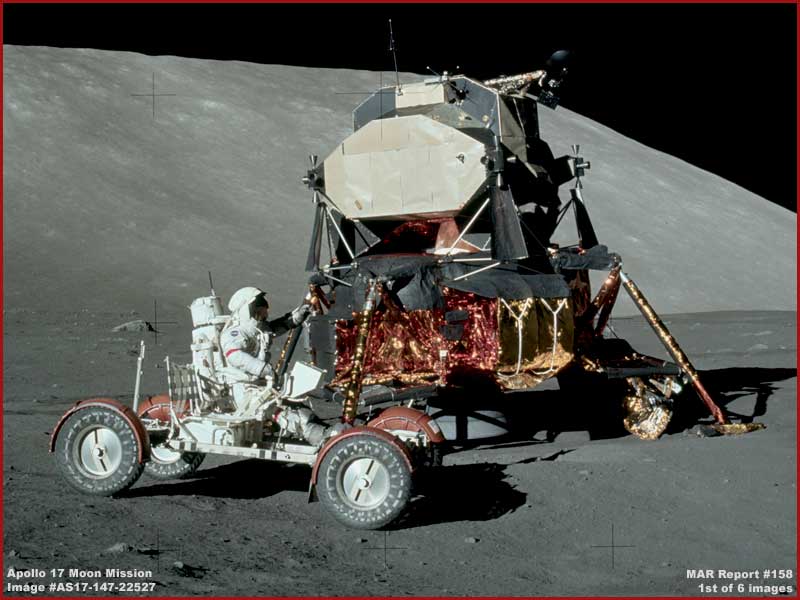
The above first image is just a context
image to familiarize some of you with the appearance of the equipment that
will be under examination here in this report. On the left in the foreground,
you see a Moon rover (LRV) with an astronaut in it and on the right just behind
the LRV you see the Moon Lunar or Landing Module (LM) with it shiny foil showing.
Note the wide stance of the LM legs and the footpad on the ground at the end
of the leg on the right.
The equipment we're looking at here is from the Apollo 17 mission which was
the last manned mission to the Moon to date as far as anything publicly admitted
to. The last three manned Apollo 15, 16, and 17 missions all had rovers. Rovers
are folded up and on a pallet that is stored against the side of the LM in
one of the areas where you see the shiny foil. Upon landing on the Moon, the
astronauts get out and drop down the pallet with the folded two person rover.
They unfold it and assemble it. All of these missions used the same type of
equipment both as to the LM and the rover.
The anomalous Moon evidence we'll be examining below in this report as just
samples will be drawn from two Moon missions, Apollo 11 and Apollo 17 and
then we'll move on to some Mars Opportunity rover evidence. The reason I'm
doing this is to demonstrate that the type of evidence you will see here spans
decades of planetary exploration from the early 1970's to the 2000's and forms
a consistent pattern of secrecy behavior and are obviously not isolated activities.
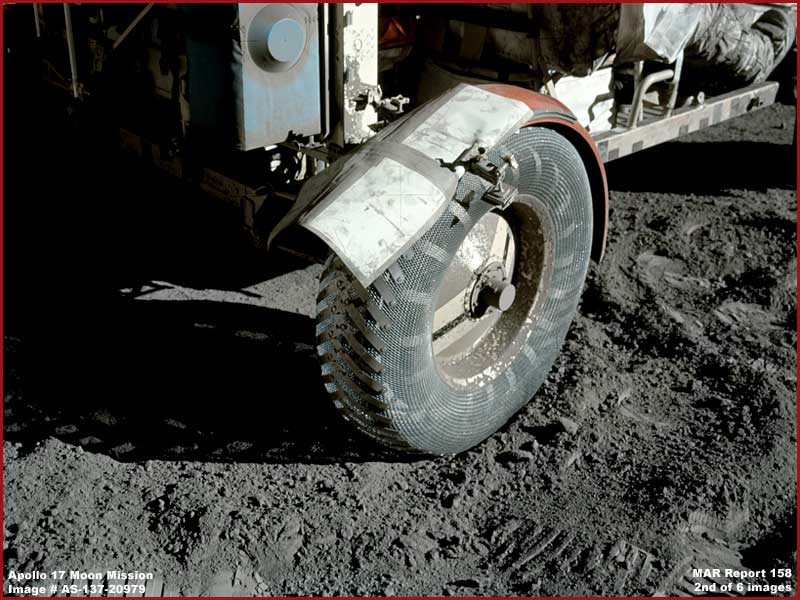
The above second image is of the Apollo
17 rover's right rear wheel/tire/fender area. This image is from one side
edge of the original image to the other. One of the astronauts damaged the
right rear fender and it was temporarily repaired with duct tape and that
is why this image was taken and what it is suppose to be all about. However,
note that the soil surface immediately in front of the tire and immediately
behind it has not been disturbed by rover tracks.
Since lifting and carefully placing the rover in a spot on the Moon is impossible
and since driving up to this position would leave tracks, then we have a problem
with the evidence in this image. Okay, I thought to myself, I gotcha. However,
as I expanded out my investigation of this, I found out that I was not the
first to find this after all. To save me reporting time on this, you'll find
some in depth interesting reporting on this at the following link http://apolloanomalies.com/rover_tracks_rebuttal.htm.
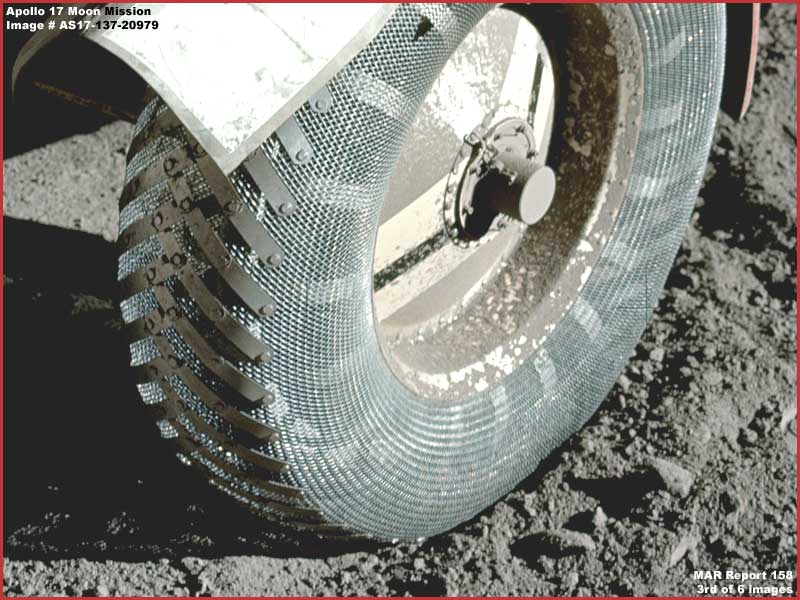
So is it a shut out for me or can
I add anything to this discovery? As it turns out, yes I believe that I can
in the above third image which is just a closer shot of the Apollo 17 rover
right rear tire and wheel. Note that the tire is covered by a what appears
to be a metal mesh and that crossing angled bands forming increased traction
cleats have been added to the bottom of the tire that makes contact with the
ground and of course should leave matching tread marks in that ground.
Now note the inner wheel and rim is covered with
what appears to be very fine texture gray soil. On the Moon that soil is called
regolith. One reason is that Moon regolith, it is theorized by the science
communities, is primarily formed by objects impacting the Moon's surface.
Over millions of years this impact and blasting effect grinds the soil up
into very fine particles that would be considered dust or powder here on Earth.
Therefore, in theory, the Moon's dusty powdery surface combined with a gravity
only a 17th as much as Earth and no moisture equates to the soil often acting
like a dry powder that when disturbed from the surface tends to hang in suspension
in the air for a while.
Note two things in the above third image. Note that the very fine grained
soil is adhering to the wheel including vertical and curving overhead surfaces
as though there was some moisture in it causing it to do so with sticking
power. That observation is significant suggesting the presence of moisture.
Yet, even as this is clearly happening on the wheel surface, note that no
soil at all, not a speck of it, appears to be adhering to the tire mesh or
the cleats including even their fasteners on the bottom of the tire. Since
much of the Moon soil is so finely textured, some of it should at least be
embedded in the mesh but obviously isn't.
This suggests that this tire may have been positioned elevated in the air
where the bottom of it was inspected and cleaned for that inspection. The
bottom of this tire has obviously not yet been rolling around on the Moon's
surface, if it is on the Moon at all, after having been cleaned. It was almost
certainly cleaned in place on the wheel because the regolith crusted on the
wheel has not been disturbed by removal from the rover. It may be that something
different than what we have been told (an astronaut using a tool accidentally
ripped the fender) happened requiring the tire to be inspected by raising
the vehicle and then lowering it back down in this spot where the image was
taken before the astronaut sitting in the rover (feet in image #2) drove it
off.
The question of course is how did the bottom of that mesh and cleated tire
surface get so clean. The lack of any rover tire tread marks in the soil both
in front and behind the tire implies that it was lowered and placed in this
spot after cleaning and that is not possible on the Moon. The astronauts do
not have the equipment for this and they are too limited in their movements
by those bulky awkward suits.
Then there is the issue of the lack of tire tracks in the soil/regolith. The
soil is plenty soft enough for tracks because the adjacent astronaut foot
prints can clearly be seen in the soil. The rover of course weighs much more
than an astronaut and should leave deeper impressions. In the 2nd image, you
can clearly see that the soil directly behind the tire is in a natural state
and undisturbed. Although foot prints have disturbed the soil immediately
in front of the tire, further forward can still be seen undisturbed soil as
well as the small piece of the right front tire and its shadow under the rover.
Obviously, the right front tire has not rolled across any of this regolith
and left an impression either.
This evidence is not alone, there is a long litany of problems with the Moon
science data like this. So you can perhaps understand why the researchers
at the above link might come to the conclusion that a lot, if not all, of
the Moon manned landing data was staged on a set here on Earth. Further, the
incentive to fabricate was certainly there. Why? Because the Russians in those
days were repeating one first after another with respect to getting into space
and dealing with the Moon. This embarrassment could certainly create motivation
for a panic to catch up here in America.
I don't profess to know the straight of it but under these playing catch up
role circumstances, the temptation to fabricate would have been very great.
It is unfortunately a too often exhibited characteristic of human behavior
both on an individual level and on a collective level any where in the world.
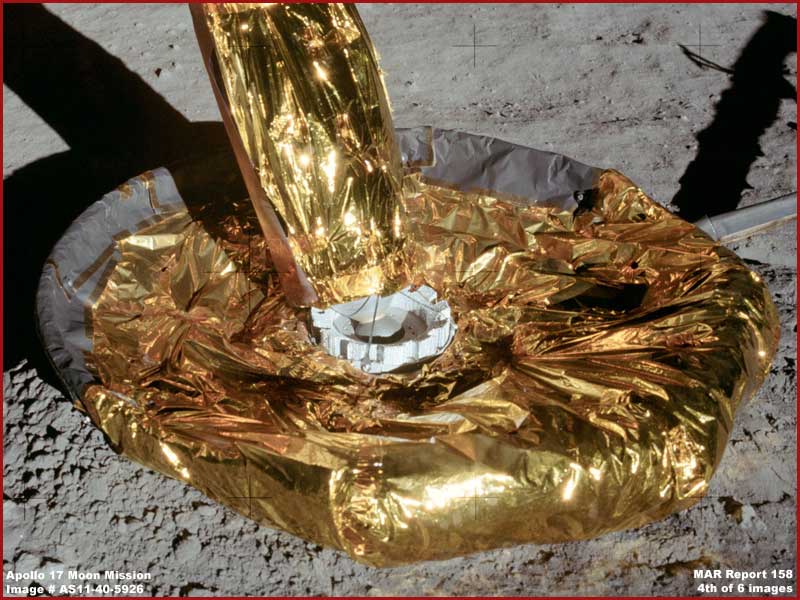
What you are looking at in the above
fourth image is one of the Apollo 11 Mission LM footpads covered in foil that
is suppose to be resting on the Moon's surface. As you can see, the round
footpad has a turned up shape at the edges forming a depression system within
the pads interior. Further, the inner surface of the shallow bowl shape consists
of all this wrinkled foil forming many different angles that would serve as
good dust traps.
The combination of shallow bowl shape and wrinkled foil forming a depression
and its location at the lowest point right against the ground is the perfect
catch system. Now consider the LM lowering down for landing on the Moon's
surface with its decent thruster burn nozzle pointed straight down right at
the ground coming to within inches of it and blowing up a cloud of Moon regolith
dust to hang suspended in the air over the site for a while in the low Moon
gravity. You know this would be so. It would be impossible for some of the
disturbed settling dust to not settle back down into this large shallow bowl
shape and the shiny foil with its many traps would show every bit of it.
However, as you can clearly see in the above 4th image, there is no sign of
any dust or regolith in this footpad shallow bowl shape. Further, it is the
same with other shots of this and other Apollo 11 LM pads at these links:
AS11-40-5902,
AS11-40-5917,
AS11-40-5918,
AS11-40-5920,
and AS11-40-5925.
When you use these confirmation links, be sure to access
the "Hi-Res" official image because it is much larger than the "standard"
image and offers a much closer view of the Apollo 11 LM footpads than you
see here confirming not a sign of dust or regolith inside the footpad shallow
bowl shape. Once again I thought to myself, yep I gotcha. I should
have known better on such older Moon material. Again, as I expanded my investigation
on this type of evidence, I found others had beaten me to the punch with some
good reporting here at http://www.aulis.com/jackstudies_22.html.
Evidence like this is small but crucial and unequivocal. Once again you can
perhaps see how others could have come to the conclusion that these Moon landings
were not real and may have been fakes. Now let's move on to the Mars evidence
below.
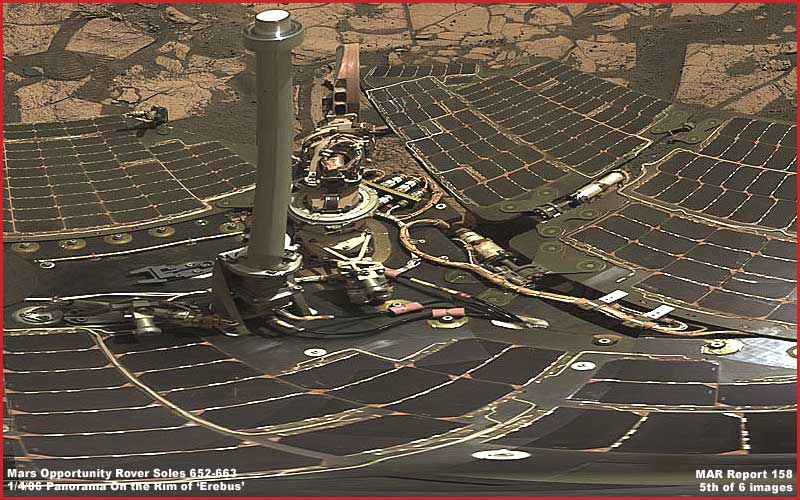
The above fifth image shows a portion
of the Mars Opportunity rover deck. This image is drawn from the official
1/4/2006 panorama titled "On the Rim of Erebus." It is a mosaic
of many smaller images taken from Sols 652 through 663. Because the whole
of this huge panorama image is a 360º view, the official original is
presented in a cylindrical projection that causes some distortion in the rover
decking you see above but this does not impact the kind of evidence presented
here.
Now what must be understood is that all of the many solar cells and many of
the other flat horizontal surfaces in this image including even the upright
mast are covered over by smudge image tampering. That is, in fact, routine
when it comes to the rover deck upper surfaces. Even so, it is not the flat
surfaces that we are interested in so much as it is the nooks and crannies
where dust and soil should collect and become trapped like at the screws,
brackets, fittings, etc. Look closely at these spots and, try as you might,
you will not find any soil or dust accumulations. In fact all this deck appears
to be in clean pristine condition.
Now think of that. This rover has theoretically been in operation moving around
on Mars for up to 663 Mars days and nights, the whole time in the open. That's
nearly 22 months our time or almost 2 years and more importantly going through
multiple warm and colder seasons and weather conditions. It has no doubt encountered
frost as well as wind blown sediment many multiples of times. Yet there is
no sign of any of this on the top deck surfaces that are natural catch systems.
Even someone cleaning the deck with air blaster would be hard pressed to have
gotten it this clean. The super clean rover looks like it just rolled out
of a lab instead of plowing around on Mars continuously in the open for hundreds
of days.
This strains credibility in obvious ways. How are we to have confidence in
data that has these kind of credibility problems in it. Do you believe that
this particular rover deck has been out in the open on Mars for nearly 2 years?
How can you? Yet that is what we are suppose to believe.
DOCUMENTATION
http://www.apolloarchive.com/apg_thumbnail.php?ptr=231&imageID=AS17-147-22527.
This link takes you to the ApolloArchive.com page for the official science
data image from which my 1st report image of the LM
and LRV together was drawn. On the page that opens, if the thumbnail
image on the left or the "Hi-Res" text link in the middle will not
work for you, then use the small text non java script "Standard"
and "Hi-Res" links on the right side of the page.
http://www.apolloarchive.com/apg_thumbnail.php?ptr=382&
imageID=AS17-137-20979. This link takes you to the ApolloArchive.com page
for the official science data image from which my 2nd and 3rd report images
of the rover right rear tire here were drawn.
On the page that opens, if the thumbnail image on the left or the "Hi-Res"
text link in the middle area will not work for you, use the small non java
script text "Standard" and "Hi-Res" links on the right
side.
http://www.apolloarchive.com/apg_thumbnail.php?ptr=622&imageID=AS11-40-5926.
This link takes you to the ApolloArchive.com page for the official science
data image from which my 4th report image of the LM
footpad was drawn. On the page that opens, if the thumbnail image on
the left or the "Hi-Res" text link in the middle area will not work
for you, then use the small text non java script "Standard" and
"Hi-Res" links on the right side of the page. You
are urged to access the "Hi-Res" image because it will display an
even larger image with a much closer view of the footpad and the absence of
regolith than you see here in this report.
http://marsrovers.jpl.nasa.gov/gallery/panoramas/opportunity/2006.html.
This link will take you to the page where the year 2006 Opportunity panorama
images are located from which the too clean rover deck
evidence was drawn. There are a large number of panoramas there listed in
order from the most recent down to the oldest in that year. This report evidence
is the last listed and so you must scroll down to the very bottom of the page
to access the 1/4/2006 "On the Rim of EreBus"
image and accompanying narrative. Note that the largest image does not display
but the "Browse" and "Medium" images do display.
, Investigator
www.marsanomalyresearch.com©
![]()